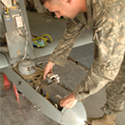Darpa to develop mobile millimeter-wave backhaul networks

Providing high-bandwidth communications for troops in remote forward operating locations is not only critical but also challenging because a reliable infrastructure optimized for remote geographic areas does not exist. When you introduce additional needs, such as communication support for data feeds from Unmanned Aerial Vehicles (UAVs) transmitting information to troops on patrol in remote areas, you face a host of new challenges where dropped signals can create a serious threat to a warfighter's situational awareness.
DARPA's recently announced Fixed Wireless at a Distance program seeks to tackle the problem of stationary infrastructure designed specifically to overcome the challenge inherent with cell communication in remote areas.
To overcome the challenge of data transmission in remote areas outside forward operating locations, the Agency's Mobile Hotspots program intends to develop and demonstrate a scalable, mobile, millimeter-wave communications backbone with the capacity and range needed to connect dismounted warfighters with forward-operating bases (FOBs), tactical operations centers (TOCs), intelligence, surveillance and reconnaissance (ISR) assets, and fixed communications infrastructure. The backbone should also provide reliable end-to-end data delivery among the hotspots, as well as from ISR sources and command centers to the hotspot users. In essence, Mobile Hotspots seeks to provide cell-tower-class performance without the infrastructure.
The program envisions air, mobile and fixed assets, most of which are organic to the deployed unit, that provide a gigabit-per-second tactical backbone network extending to the lowest-echelon warfighters. To achieve this, the program seeks to develop advanced pointing, acquisition and tracking (PAT) technologies, not commercially available, needed to provide high connectivity to the forward-located mobile hotspots. Advanced PAT technology is key for connectivity to small UAVs, for example, enabling them to serve as flying nodes on the mobile high-speed backbone.
“While some advanced commercial millimeter-wave components can be leveraged for this program, the technical challenge is more complex given the infrastructure and terrain challenges of a forward-operating locations,” said Dick Ridgway, DARPA program manager. “Mobile Hotspots will require the development of steerable antennas, efficient millimeter-wave power amplifiers, and dynamic networking to establish and maintain the mobile data backhaul network. We anticipate using commercial radio protocols, such as WiFi, WiMax or LTE [Long Term Evolution], as a cost-effective demonstration of the high-capacity backbone. However, the millimeter-wave mobile backbone developed during this program will be compatible with other military radios and protocols.”
Additionally, the program seeks novel technologies to increase the transmission power to provide adequate ranges within the small size, weight, and power (SWAP) constraints required for company-level unmanned aerial vehicles (UAVs).
Provided by DARPA


















